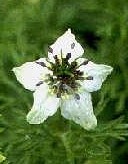 Native to parts of Asia, this annual herb is also known as black caraway, fennel flower, nutmeg flower, and Roman coriander, but these names are generally misleading and do not suggest the flavor of the seeds that are the main reason for growing the plant. The seeds have a bitter taste and are used in Asian and Middle Eastern cuisine to flavor many foods including pastry, breads, vegetables, curry and cheese. They are also thought to have medicinal value in the treatment of a variety of ailments including hypertension, allergies, rheumatoid arthritis, asthma, and cancer. The plant has feathery foliage and delicate flowers about an inch across with five to ten blue or white petals. The fruits are large and contain numerous of seeds. The genus name, Nigella, is derived from the diminutive form of the Latin word niger meaning black, and refers to the color of the seeds. The specific name sativa means that which is sown, i.e. “cultivated”.
Native to parts of Asia, this annual herb is also known as black caraway, fennel flower, nutmeg flower, and Roman coriander, but these names are generally misleading and do not suggest the flavor of the seeds that are the main reason for growing the plant. The seeds have a bitter taste and are used in Asian and Middle Eastern cuisine to flavor many foods including pastry, breads, vegetables, curry and cheese. They are also thought to have medicinal value in the treatment of a variety of ailments including hypertension, allergies, rheumatoid arthritis, asthma, and cancer. The plant has feathery foliage and delicate flowers about an inch across with five to ten blue or white petals. The fruits are large and contain numerous of seeds. The genus name, Nigella, is derived from the diminutive form of the Latin word niger meaning black, and refers to the color of the seeds. The specific name sativa means that which is sown, i.e. “cultivated”.
Type: Annual
Bloom: Blue or white flowers with five to ten petals appear in summer
Size: 12-18” H x 9-12” W
Light: Full sun
Soil: Average, medium dry, well-drained
Hardiness: Zones NA
Care: Low maintenance
Pests and Diseases: None of significance
Propagation: Seed
